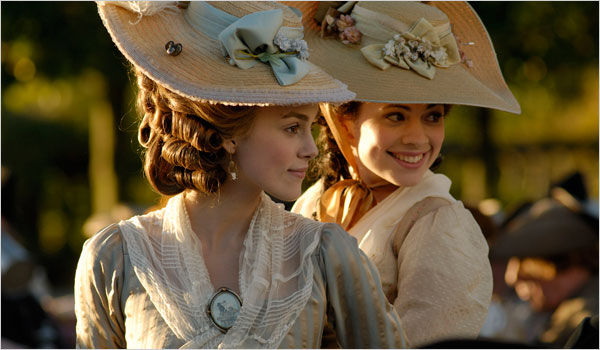|
Reviews of Recent Independent, Foreign, & Documentary Films in Theaters and DVD/Home Video

THE DUCHESS Author Amanda Foreman describes the subject of her biography Georgiana, Duchess of Devonshire as “not classically pretty, but she was tall, arresting, sexually attractive and extremely stylish” (and dubbed the Empress of Fashion.) Although coltish Keira Knightley may be too good-looking to fit that description, she otherwise fits the bill. Donning a three-foot-high hairpiece with cascading plumage, she towers over everyone like a giantess. Of course, this being a movie, artistic license was taken, and then some, but the essence of the ingratiating and naïve young woman from Foreman’s work comes through. Née Spencer, Georgiana marries at 17 to the much older and standoffish Duke of Devonshire in 1774. She hopes for love, he for a male heir. She produces two children—daughters. Eventually, there are three in the marriage when her closest confidant becomes her husband’s mistress. Divorce, let alone remarriage, would mean a precipitous social downfall. The triangle is the film’s most direct reference to Georgiana’s descendant (and fellow press magnet) Diana, Princess of Wales. Troubled marriages aside, other parallels are inferred. The dialogue elegantly echoes the beautifully written letters which form much of the backbone of Foreman’s book. She presumably signed on to the film’s factual changes; she’s one of the executive producers. According to the biography, the duchess’s marriage was far more complicated and not nearly as poisonous as the film depicts it to be. But the best moments are when the duke exercises his male prerogative. He’s a villain to hiss at, though Ralph Fiennes valiantly attempts to humanize him, with a flash of a wry sense of humor or a look of utter bewilderment at his wife’s combativeness. Knightley, on the other hand, is more effecting in her quieter moments than in the big, dramatic confrontations. Her jaw tenses as she forcibly emotes, a tic seen in some of her earlier roles. We have to take the film at its word that the duchess was an important figure during the Enlightenment. The film eavesdrops behind closed bedroom doors, not the smoke-filled backrooms of the Whigs or Tories. As a political force, she is seen as little more than a fashionable accessory on the campaign trail for future Prime Minister Charles Fox. Despite the on-location backdrop of
the duke’s ancestral estate, Chatsworth, and the elaborate wardrobe, the
film paints a decidedly anti-Barbara Cartland view of romance. When a
bodice is ripped, it’s not in the heat of passion. The viewer will
likely come away feeling depressed but relieved to be living in another
century; Rachel Portman’s period-flavored and morose score lays on the
gloom thickly. But most of all, the film rehabilitates the duchess,
sanitizing her behavior—she gambled away staggering sums and became
addicted to laudanum, for starters. Whereas she leaps off the pages of
Foreman’s book, on film, she’s depressed and royally screwed. Kent
Turner
|

